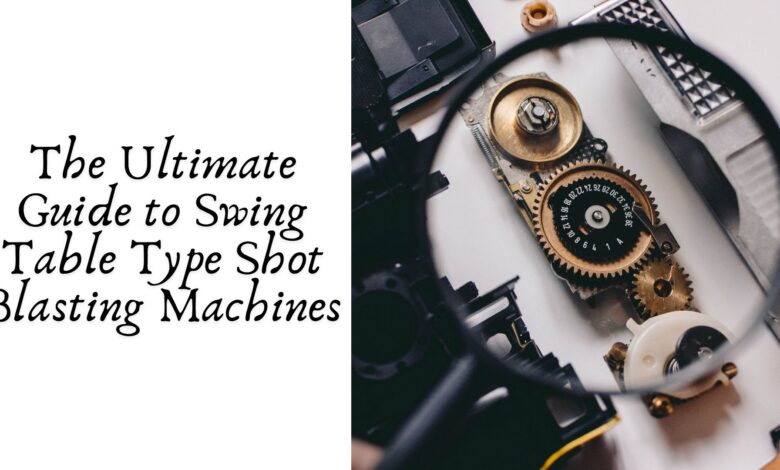The Ultimate Guide to Swing Table Type Shot Blasting Machines

Shot blasting is a critical process in many industries for cleaning, strengthening, and polishing metal surfaces. Among the various types of shot blasting machines, swing table type shot blasting machines hold a prominent place due to their versatility and efficiency. This guide will delve deep into the intricacies of these machines, covering their design, functionality, applications, benefits, maintenance, and safety considerations.
Introduction to Shot Blasting
Shot blasting is a surface treatment process using high-velocity steel abrasives to clean, reinforce, or polish materials. It’s commonly employed in the automotive, aerospace, construction, and shipbuilding industries. The primary objective is to remove surface contaminants like rust, scale, paint, or other coatings and to impart a desired surface finish.
What is a Swing Table Type Shot Blasting Machine?
A swing table type shot blasting machine is a specific kind of shot blasting equipment that features a rotating table or platform. The workpieces are placed on this table, which swings or rotates within the blasting chamber. This design is particularly suitable for treating large, heavy, and complex-shaped parts that might be challenging to handle with other types of shot blasting machines.
Components of a Swing Table Type Shot Blasting Machine
- Blasting Chamber: The enclosed space where the blasting takes place.
- Swing Table: The rotating platform on which workpieces are placed.
- Blasting Wheels: High-speed turbines that propel the abrasive material onto the workpieces.
- Abrasive Recovery System: Collects and recycles the abrasive material for reuse.
- Dust Collection System: Filters and removes dust generated during the blasting process.
- Control Panel: Allows operators to manage and monitor the blasting parameters.
How Swing Table Type Shot Blasting Machines Work
The operation of a swing table type shot blasting machine involves several steps:
- Loading: Workpieces are placed on the swing table, either manually or using lifting equipment.
- Sealing: The machine door is closed to seal the blasting chamber.
- Blasting: Blasting wheels accelerate the abrasive material, which impacts the workpieces, cleaning and finishing their surfaces.
- Swinging: The table rotates or swings to ensure all sides of the workpieces are evenly blasted.
- Recovery: Used abrasives are collected, cleaned, and recycled.
- Unloading: The cleaned workpieces are removed from the machine.
Applications of Swing Table Type Shot Blasting Machines
Swing table type shot blasting machines are versatile and used in various industries for different applications:
- Automotive Industry: Cleaning engine blocks, chassis components, and other large metal parts.
- Aerospace Industry: Surface preparation of aircraft components for painting or coating.
- Construction Industry: Cleaning structural steel, beams, and girders.
- Shipbuilding Industry: Removing rust and scale from ship parts and hulls.
- Foundries: Cleaning castings and forgings to remove sand, scale, and other residues.
Benefits of Using Swing Table Type Shot Blasting Machines
Enhanced Surface Quality
The rotating action of the swing table ensures comprehensive surface treatment, resulting in uniform and high-quality finishes.
Increased Efficiency
The ability to handle large and heavy parts makes these machines highly efficient for industrial applications, reducing the time and labor required for manual cleaning.
Cost-Effective
The abrasive recovery system minimizes material wastage, making the process more economical in the long run.
Versatility
These machines can accommodate a wide range of part sizes and shapes, providing flexibility for different applications.
Maintenance of Swing Table Type Shot Blasting Machines
Regular maintenance is crucial to ensure the longevity and optimal performance of swing table type shot blasting machines. Key maintenance tasks include:
Daily Checks
- Inspect the blasting chamber for wear and tear.
- Check the abrasive levels and replenish as needed.
- Ensure the dust collection system is functioning properly.
Weekly Maintenance
- Clean the abrasive recovery system and check for blockages.
- Lubricate moving parts as per the manufacturer’s recommendations.
- Inspect and clean the blasting wheels.
Monthly Maintenance
- Perform a detailed inspection of the swing table mechanism.
- Check the electrical components and wiring for any issues.
- Replace worn-out parts to prevent breakdowns.
Annual Maintenance
- Conduct a thorough inspection of the entire machine.
- Replace any major components that show signs of significant wear.
- Update software or control systems if required.
Safety Considerations
Safety is paramount when operating swing table type shot blasting machines. Key safety measures include:
Personal Protective Equipment (PPE)
Operators should wear appropriate PPE, including helmets, gloves, safety goggles, and hearing protection.
Training
Ensure all operators are adequately trained in the safe operation of the machine, including emergency procedures.
Machine Safety Features
Regularly inspect and test safety features such as emergency stop buttons, interlock systems, and protective guards.
Ventilation
Maintain proper ventilation to manage dust and airborne particles generated during the blasting process.
Conclusion
Swing table type shot blasting machines are a vital asset in industries requiring thorough and efficient surface treatment of large and complex parts. Understanding their operation, benefits, maintenance needs, and safety considerations can significantly enhance their performance and longevity. By investing in these machines and maintaining them properly, industries can achieve superior surface finishes, improved efficiency, and long-term cost savings.
Name: Process & System
Address: Modi House, Ground Floor, 14, Raja Naba Krishna Street, Kolkata – 700 005, WB, India
P.No.: 9051202216



